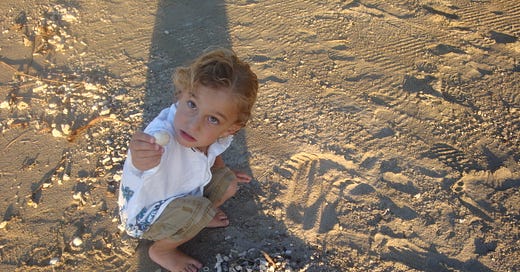I did not bring my children into this world to bestow unto them a dying planet.
and other thoughts on why I started this journey
Valclav Havel says hope is the “ability to work on something because it is good, not because it has a chance to succeed.”
When I took three-year-old Kai to the Great Barrier Reef, I didn’t know I had brought him to his first graveyard. He won’t remember us standing on an island of bleached and broken coral. Nor how we swam searching for color in the reef, getting too excited over dull peeks of pink. He only knows that after we left, a cyclone destroyed the island we visited, rendering it uninhabitable for living creatures.

When we left Australia, I knew I had to do something to find hope, so I set out to take the kids to see places that might not exist in their lifetimes. I imagined that introducing them to the world I adored would inspire them to love this planet and need to become caretakers themselves.
In the past ten years, we’ve visited too many places that are now directly changed because of our climate crisis. It’s impossible to ignore the impact of humans on our warming world when standing on polluted shorelines of Latin America, watching tourists sip glacier melt from plastic water bottles on a retreating glacier, trying to find specks of color in bleached reefs, or gasping for fresh air in wildfire-stricken California.
I knew I had to do more, but what?
For research in my book project, I recently interviewed David Katz, CEO and founder of Plastic Bank, an organization that monetizes plastic as currency to feed, house and educate the planet’s most impoverished residents. I’d watched his inspiring TED Talk with Kai that morning, and Kai told me to ask Mr. Katz if there’s any hope for his future.
In response to Kai’s question, David Katz told me to do the following (you should try it, really, take a minute and try it right now):
“Look at your bookshelf, or in your pantry and focus on everything that’s red. Focus on the spines, the lettering, everything, so you can tell me all about every single red thing. Give yourself a full minute.”
“Now, without looking, tell me everything that’s blue.”
Mr. Katz laughed off my confusion, explaining that we’re going about this all wrong by focusing on the problems. We need to urge people to look at the solutions so they can innovate and create solutions themselves, not just for humans, but for all the planet’s species.
“The work we must do as stewards for this earth are for a future we will not see.” In effect, he explained, we are trying to steward a future not just where our children have the chance to be ancestors, but also one where the planet’s wolves and banana slugs and elephants and redwoods can continue to thrive.
This Week’s Solution Challenge
Instead of focusing on the problems around you, look for one climate solution being implemented in your community. Feel free to share it here, post it on your socials (and share with me), help other people see a solution, not just all the problems. If nothing else, it’ll bring you a glimpse of sunshine through the ash and fog hanging over us all.
Until next week…




This is a bit banal, but I have always loved Earth-Baby, the diaper service that composts diapers so that they don't fill up landfills and promote more plastic use. It's a Santa Cruz-based company, I used them when both my kids were babies, and I never stop talking about it to friends. While I'm sure there are still negative externalities, it seems like such a good solution in so many ways to breaking one aspect of our addiction to plastic. More than anything, I love this kind of innovation, where someone sees a problem--even a super everyday kind of problem--and takes action.